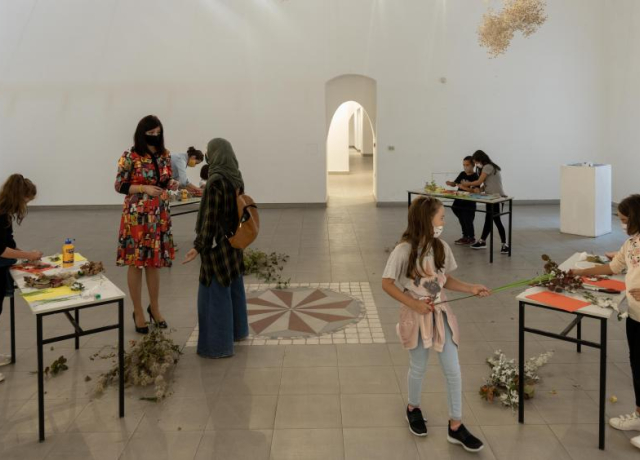European Heritage Days Article:
Sustainable Heritage Events and Competitions for Children
European Heritage Days Article:
Sustainable Heritage Events and Competitions for Children
Plan events for children and schools
A great way to get children actively involved in events is through encouraging them to make something for themselves. Art classes or competitions are a fun option for young people to draw, paint, make objects or photograph something which represents how they feel about sustainability issues, whether that’s supporting nature and the environment or the continuation of cultural traditions. These kinds of ideas could even have a focus on using natural materials, such as traditional crafts using reeds, straw or wood, or encourage children to be inventive by using recycled materials from home.
Fashion events might be another popular option. Think about how workshops can be held to create traditional cultural items which represent local identities, and get a tailor or other expert to teach the methods needed. Or why not ask teenagers to borrow items from their grandparents for a fashion show - did you know that there are enough garments on the planet to clothe the next 6 generations? Another interactive option is a ‘swop shop’ where children bring in items they no longer wear to exchange for others, which can be an exciting way to think about reducing the carbon footprint of clothing.
Head outdoors and encourage children to enjoy and learn more about nature. Challenge them to become nature detectives with a special quiz or hunt outside by putting together series of clues to solve or by creating a list of flora and fauna to spot or draw! A specific idea for this could be a leaf hunt to showcase the biodiversity of the area, and these could also be used for leaf rubbings to add an extra creative element to the game. Thinking about the future, you could also plan a tree planting ceremony, while a special screening of a film such as ‘Bee Movie’ is an entertaining way to teach primary school children about natural processes such as pollination.
It’s not just nature which can be found outdoors, there’s plenty of inspiration for sustainability events in the buildings and urban environment too. Have you ever heard of ‘plogging’? This Swedish concept, merging ‘jogging’ and ‘picking up litter’, is a fun and healthy way to help keep local areas clean and tidy and would make a great activity for #WorldCleanupDay on Saturday 17th September. For another kind of activity, a scavenger hunt could include historic features on buildings, different types of sustainable building materials and techniques and decorative designs featuring animals or plants in murals, carvings and stained glass.
Discussing sustainability issues and encouraging collaboration are helpful ideas for the basis for events, and with a little planning can be tailored to children of different ages. Recycling is a good starting point – set up a display in a public area using images to compare today’s disposable products with those used by previous generations. Schools can take this idea further by joining the #PlasticFreeChallenge to empower children to help reduce waste. Older children might also be interested in e-waste reduction and anti-obsolescence of technology items through letter writing to politicians and manufacturers asking them to extend the lifespan of mobile phones and electrical items. And another important discussion to be had is about the wider impact of climate change on cultural and natural heritage - ask children for their views and get them to list everyday actions they can take to help care for the planet.
Young European Heritage Makers competition
Every year, European Heritage Days runs a special Young European Heritage Makers competition as a way of engaging with younger audiences. It “aims to give voice to the youngest, encourage them to explore their history and heritage, and get involved in the European-level celebrations of European Heritage Days”. Overseen by mentors, visual representations of an aspect of heritage are created by either individuals or groups, split into age categories of 6-10 and 11-17. Both tangible places like a building or natural landscape, or intangible aspects of heritage such as the creative arts or local cultural traditions are eligible for submission, and the project encourages exploration of issues which are important to the children themselves.
Last year’s winners included a project in Finland in which younger children learnt about the childhood of their parents and grandparents through toys, games and fairytales, while a class of children in Slovenia researched the history of the mills on the Vrtovinšček stream by connecting with other residents of the village to hear their stories and create posters and scale models of the waterwheels. In Montenegro, children in the upper age bracket created a 5-minute short film called ‘Memories’ depicting a girl being shown around Podgorica on her first day in the city and highlighting places such as the clock tower, the railway station, the mosque in the old town and the Church of Sveti Djordje to show the significance of these cultural monuments to residents and tourists.
This year’s Young European Heritage Makers competition will take place in August 2022, and more details are due to be announced soon. To stay up-to-date on all our announcements and projects, sign up to our newsletter or follow European Heritage Days at @JEP_EHD on Twitter, @EHDays on Facebook or @europeanheritagedays on Instagram using the hashtag #HeritageMakers for our Young European Heritage Makers competition.
